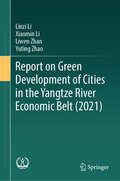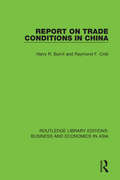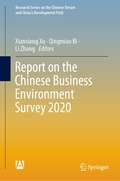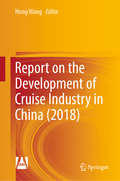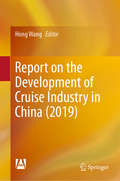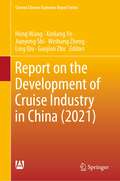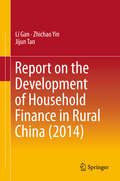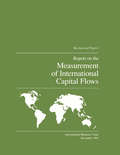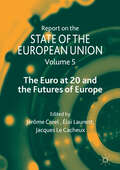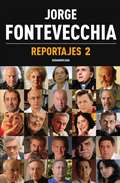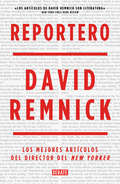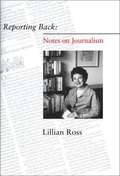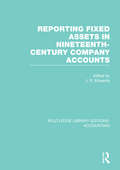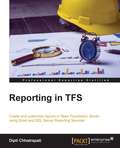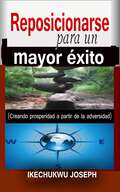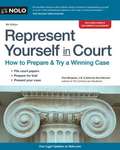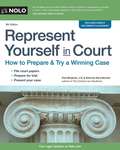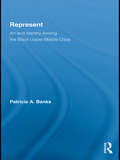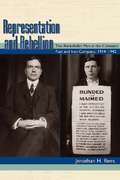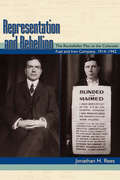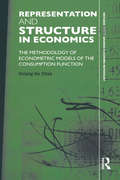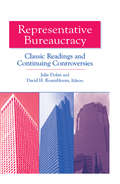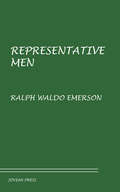- Table View
- List View
Report on Green Development of Cities in the Yangtze River Economic Belt (2021)
by Yuting Zhao Linzi Li Xiaomin Li Liwen ZhanThe report aims to help the cities in the Yangtze River Economic Belt of China identify their potentials for green development, especially to find their own suitable green development paths. Based on the evaluation, six green development models that can be replicated and promoted are initially established by selecting typical cities as pilot. The report is the first volume of its series and will be updated annually with more abundant green development models.
Report on Trade Conditions in China (Routledge Library Editions: Business and Economics in Asia #29)
by Harry R. Burrill Raymond F. CristThis study, first published in 1906, examines the position of the United States in the markets of the Chinese Empire and the steps necessary to insure a greater development of American commerce in the Far East.
Report on the Chinese Business Environment Survey 2020 (Research Series on the Chinese Dream and China’s Development Path)
by Li Zhang Xianxiang Xu Qingmiao BiThis book provides quantitative indicators covering four main areas of business environment in China. The most distinguished feature of this book is that it evaluates Chinese business environment from the perspective of enterprises based on two years' nationwide survey, interviewing 15,000 enterprises in 300 One-Stop Shops across China from 2018 to 2019, which includes: (1) Progress of Chinese business environment in 2019; (2) overview of the facilities and services of China's One-stop Shops; (3) construction and popularity of Chinese digital government system; (4) the effect of Chinese business environment on improving economic performance in terms of entrepreneurship, innovation, and economic growth. The quantitative analysis of this book shows that in 2019, China made noteworthy improvements in the process of reducing permits, increasing the availability of digital government, and improving the government efficiency. Challenges such as uneven progress among sub-regions and difficulties for small enterprises to grow were still getting in the way. The goal of the book is to provide objective data and cases from enterprise survey for use by academics and governments. This book presents Chinese experiences of designing sound business regulatory policies.
Report on the Development of Cruise Industry in China (2018)
by Hong WangThis book is an annual research report prepared by the cruise industry experts and scholars at home and abroad invited by Shanghai International Cruise Business Institute based on the current development situations of the international cruise industry, is an important part of the “X Book Series” of the Social Science Academic Press (China). This book consists of five parts, i.e., “General Report”, “Special Articles for High-quality Tourism: Common Value and Government Management”, “The Cruise Industry”, “Policy Suggestions” and “Appendix”, and it has richer and more perfect contents in comparison with the previous versions. Under the Book, the development environment of the cruise industry at home and abroad during 2017-2018 as well as the development situations, strategic paths and future trends is analyzed in the form of the General Report and the current development trend of the cruise industry in China is introduced based on the top ten hot topics. With the economic development trend from the high-speed growth to the high-quality development in China, the new topic “Special Articles for High-quality Tourism: Common Value and Government Management” is presented in the Book to discuss the quality development patterns and paths of the cruise tourism in China, the high-quality development mechanism of the cruise tourism as well as the cruise tourism market cultivation and standardization system, so as to better enhance the quality of the cruise market development in China. In Part 3 “The Cruise Industry” and Part 4 “Policy Suggestions” under the Book, the whole picture of the cruise economy in China in the new era is presented, problems during the industrial development are analyzed and corresponding policy suggestions are given.
Report on the Development of Cruise Industry in China (2019)
by Hong WangThe book focuses more on the study of cruise economy industry chain based on the previous editions and the latest trend of China’s cruise economy. It includes the Special Topic: Cruise Economic Reform and Innovation in the New Era, explores Asia cruise economic prosperity index, China’s cruise economy whole-industry-chain strategy in the new era, and the development of cruise destinations in the context of the Yangtze River Delta integration. The volume provides a good reference for better promoting the high-quality development of China’s cruise market.
Report on the Development of Cruise Industry in China (Current Chinese Economic Report Series)
by Hong Wang Ling Qiu Xinliang Ye Jianyong Shi Weihang Zheng Guojian ZhuThis book is an annual research report on the cruise industry in China and throughout the world in 2021, contributed by Shanghai University of Engineering and Technology and Shanghai International Cruise Economic Research Center. This volume consists of four parts to discuss general and special topics on global and China’s cruise industry covering respond to COVID-19, cruise tourism market, public health emergency mechanism. It offers an all-rounded perspective and a strong foresight, as well as systematic studies on China's cruise industry in the context of routine COVID-19 control and the new dual circulation development pattern. And as 2021 marks the beginning of the 14th FYP period when various plans for the cruise industry were rolled out to chart the course and strategic paths toward development for the cruise industry, it focuses also on developments in China's cruise industry.
Report on the Development of Household Finance in Rural China
by Li Gan Zhichao Yin Jijun TanThe book reports on the development of householdfinances in rural China. It is based on the results of an on-site surveyconducted door to door by a research team from the Survey and Research Centerfor China Household Finance, the largest survey center in China - and perhapsthe world - that specializes in Chinese household finances. Directed byfinancial experts that enjoy the highest honors in their field and the largest interviewer group in China, it reveals the most realisticpicture of rural China available today and highlights a topic about whichpeople worry most: household finances. By reading this inspiring report,readers will be able to better understand China from a household financeperspective.
Report on the Measurement of International Capital Flows
by International Monetary FundA report from the International Monetary Fund.
Report on the State of the European Union: Volume 5: The Euro at 20 and the Futures of Europe (Report On The State Of The European Union Ser.)
by Éloi Laurent Jacques Le Cacheux Jérôme CreelThis volume, the fifth instalment of the classic Report on the European Union series, offers at once an economic and intellectual historical perspective on the creation of the euro and its 20 first years, a comprehensive review of the current and future challenges of the euro area, including a critical look at the different options for the reform of its governance and institutional architecture and finally a close look at the “new euros”, i.e. the ambitious projects that could instil a new life into the stalled European project. It covers a wide range of key economic and social topics such as monetary and fiscal policy, tax competition, the EU budget, structural policy, inequality, gender equality, post carbon economy, well-being advancement and democracy. Weakened by a decade of economic crisis and shaken by the awakening of populism, the European project faces three disintegrations: democratic disaffection, monetary and financial fragmentation and territorial dislocation. If EU member states want to escape those looming risks, they must, as they always have in the last five decades, reinvent Europe in order to save it.
Reportajes 2
by Jorge FontevecchiaLas entrevistas periodísticas se habían vaciado de contenido en nuestropaís hasta que Jorge Fontevecchia las volvió a convertir en un suceso. Ala manera de los grandes intelectuales del siglo XIX, Fontevecchia haceuso de una vasta y múltiple formación, que le permite preguntar yrepreguntar como psicólogo, filósofo, politólogo y economista. Contra el vértigo muchas veces insustancial de la agenda noticiosa,Jorge Fontevecchia propone cada semana desde el diario Perfil unejercicio fascinante y necesario: detenernos a pensar durante laspáginas que sean necesarias, hacer todas las preguntas, perseguir lasmejores respuestas. Sus reportajes, charlas de varias horas con losverdaderos protagonistas de la vida nacional, están llamados a quedarcomo un hito periodístico, como un espacio único.HORACIO VERBITSKY / LUIS D#ELÍA / RAÚL CASTELLS / JOSÉ PABLO FEINMANN /JULIO BÁRBARO / MARIO BUNGE / ALFREDO DE ANGELI / JULIO CÉSAR CLETOCOBOS / HORACIO GONZÁLEZ / PINO SOLANAS / FELIPE SOLÁ / VICTORIA DONDA /SERGIO SCHOKLENDER / JORGE CORSI / EDUARDO DUHALDE / PALITO ORTEGA /MARCOS AGUINIS / JULIO CÉSAR GRASSI / HILDA MOLINA / FRANCISCO DENARVÁEZ / HÉCTOR AGUER / JULIO GRONDONA / ELISA CARRIÓ / ESTELA DECARLOTTO / SANDRA MENDOZA#¿Cuál es su secreto? ¿Qué vende? ¿A qué se dedica realmente? ¿Cuál essu producto? ¿Qué busca? ¿Quiere lo que desea? ¿Con qué goza? No fuerondiferentes las preguntas que me realicé a mí mismo sobre cadaentrevistado que las que se podría hacerse cualquier psicoterapeutafrente a un nuevo #cliente#. Entenderlos significa periodísticamenteentendernos a nosotros mismos. Ellos, los entrevistados, son nuestroespejo. Son nosotros. Están ahí, en su posición de sujetos noticiosos,también por nosotros. Explicar racionalmente lo irracional de ellos estambién explicarnos como sociedad.#
Reportero: Los mejores artículos del director del New Yorker
by David RemnickLas mejores piezas del director del New Yorker, un maestro del periodismo contemporáneoDavid Remnick tiene el don poco común de revelar a los lectores el alma y la mente de las figuras públicas. Su penetrante mirada disecciona a políticos, escritores o púgiles, y su pluma sirve unos retratos perfectamente aliñados. Remnick logra combinar en sus vívidas piezas una extraordinaria claridad con la profundidad del mejor periodismo.Reportero reúne sus mejores textos de los últimos 20 años, desde la política estadounidense a la Rusia post soviética, pasando por Hamás, Tony Blair, Bruce Springsteen, Solzhenytsin o Philip Roth.
Reporting Back: Notes on Journalism
by Lillian RossI would encourage anyone who is doing any kind of writing to read the introduction to this book. Ross is a talented and ethical journalist who can teach students and writers a lot in those first few pages. An entertaining and informative book.
Reporting Fixed Assets in Nineteenth-Century Company Accounts: Accounting: Reporting Fixed Assets In Nineteenth-century Company Accounts (Routledge Library Editions: Accounting)
by J. R. EdwardsThis book focuses on the way in which businessmen responded to the new problem of accounting for fixed assets when measuring periodic profit. The book is divided into four sections: the first embraces items that examine asset valuation procedures in general use during the nineteenth century. The second focuses on the particular practices that became popular among public utility companies. The third comprises studies on influences, particularly legal ones on the treatment of fixed assets in company accounts. The final section examines the likely economic effect of using particular valuation procedures and is another area where available material is scarce. Of the twenty-seven items included, seven were written during the nineteenth century and the remainder during the twentieth. Their emphasis is practical rather than theoretical: they set out the various ways in which companies accounted for fixed assets and provide some explanation for the choices made.
Reporting in TFS
by Dipti ChhatrapatiThis book is intended for developers, testers, architects, and project managers who want to explore and make use of the reporting facilities of Team Foundation Server 2013. Although no previous experience of reporting is required, a basic understanding of the Team Foundation Components and project templates would be a plus.
Reports: Where Managers Find Information
by William J. Bruns Jr. Sharon M. MckinnonInformation flows to managers in many different ways. This chapter looks at reports, identifying those that are most useful to production managers, sales and marketing managers, financial managers, and general managers.
Reposicionarse para un mayor éxito
by Ikechukwu JosephReposicionarse para un mayor éxito (Crear prosperidad a partir de la adversidad) es una gran guía para aquellos que quieren tener éxito en la vida, la carrera, la profesión o el ministerio, superando los desafíos de la vida. Aprenda las herramientas de reposicionamiento, reajuste de la reflexión, reequipamiento, reordenación, retrospección, reagrupación, reprensión, redención, reforma, acceso, ensayo, reconciliación, regeneración, resolución, reingeniería.
Repositioning CARE USA
by V. Kasturi Rangan Katharine LeeCARE USA, a large ($600 million) international nonprofit/NGO, had recently revamped its external branding and positioning in support of its international development work. The case lays out the challenges facing its new CEO, Helene Gayle, as she manages through the organization's transition.
Represent Yourself in Court
by Paul Bergman Sara J. BermanSometimes it makes sense to handle a court case without an attorney. Learn about acting as your own lawyer in Nolo's easy to use, plain English guide, Represent Yourself in Court. This book breaks down the trial process into easy to understand steps so that you can act as your own lawyer safely and efficiently. Find out what to say, how to say it even where to stand when you address the judge and jury. Get details on how to: - file court papers - handle depositions and interrogatories - comply with courtroom procedures - pick a jury - prepare your evidence and line up witnesses - present your opening statement and closing argument - cross examine hostile witnesses - understand and apply rules of evidence - locate, hire and effectively use expert witnesses - make and respond to your opponent's objections - get limited help from an attorney as needed - monitor the work of an attorney if you decide to hire one Whether you're a plaintiff or a defendant, this book will help you confidently handle a divorce, personal injury case, landlord/tenant dispute, breach of contract, small business dispute, or any other civil lawsuit. This edition has been revised with the latest rules and court procedures, and includes updated information on electronic discovery rules and fax filing procedures. Plus, you'll get enhanced materials on court assistance for pro per litigants and an expanded discussion of self representation in bankruptcy court.
Represent Yourself in Court: How to Prepare & Try a Winning Case
by Paul Bergman Sara J. BermanHow to prepare and present a winning civil court case Many disputes are too big for small claims court but too small to justify a lawyer's fee. Fortunately, if you are willing to learn the courtroom ropes, you can successfully handle your own case from start to finish. Represent Yourself in Court breaks the pretrial and trial process down into easy-to-understand steps. Armed with these clear and thorough instructions, you'll be well prepared to: file court papers present an opening statement deal with pretrial issues cross-examine hostile witnesses handle depositions make and respond to objections pick a jury if necessary get help from an attorney or legal coach discover, obtain and prepare your evidence deal with the court clerk and judge line up and prepare witnesses Whether you are a plaintiff or a defendant, this book will help you handle a bankruptcy, divorce, landlord-tenant dispute, breach of contract case, small business dispute--or any other civil lawsuit. This new edition is completely updated to include the latest rules and court procedures.
Represent: Art and Identity Among the Black Upper-Middle Class (Routledge Research in Race and Ethnicity)
by Patricia A. BanksPatricia A. Banks traverses the New York and Atlanta art worlds to uncover how black identities are cultivated through black art patronage. Drawing on over 100 in-depth interviews, observations at arts events, and photographs of art displayed in homes, Banks elaborates a racial identity theory of consumption that highlights how upper-middle class blacks forge black identities for themselves and their children through the consumption of black visual art. She not only challenges common assumptions about elite cultural participation, but also contributes to the heated debate about the significance of race for elite blacks, and illuminates recent art world developments. In doing so, Banks documents how the salience of race extends into the cultural life of even the most socioeconomically successful blacks.
Representation and Rebellion
by Jonathan H. ReesIn response to the tragedy of the Ludlow Massacre, John D. Rockefeller Jr. introduced one of the nation's first employee representation plans (ERPs) to the Colorado Fuel and Iron Company in 1915. With the advice of William Mackenzie King, who would go on to become prime minister of Canada, the plan - which came to be known as the Rockefeller Plan - was in use until 1942 and became the model for ERPs all over the world. In Representation and Rebellion Jonathan Rees uses a variety of primary sources - including records recently discovered at the company's former headquarters in Pueblo, Colorado - to tell the story of the Rockefeller Plan and those who lived under it, as well as to detail its various successes and failures. Taken as a whole, the history of the Rockefeller Plan is not the story of ceaseless oppression and stifled militancy that its critics might imagine, but it is also not the story of the creation of a paternalist panacea for labor unrest that Rockefeller hoped it would be. Addressing key issues of how this early twentieth-century experiment fared from 1915 to 1942, Rees argues that the Rockefeller Plan was a limited but temporarily effective alternative to independent unionism in the wake of the Ludlow Massacre. The book will appeal to business and labor historians, political scientists, and sociologists, as well as those studying labor and industrial relations.
Representation and Rebellion: The Rockefeller Plan at the Colorado Fuel and Iron Company, 1914-1942 (G - Reference, Information And Interdisciplinary Subjects Ser.)
by Jonathan H. ReesIn response to the tragedy of the Ludlow Massacre, John D. Rockefeller Jr. introduced one of the nation’s first employee representation plans (ERPs) to the Colorado Fuel and Iron Company in 1915. With the advice of William Mackenzie King, who would go on to become prime minister of Canada, the plan—which came to be known as the Rockefeller Plan—was in use until 1942 and became the model for ERPs all over the world.In Representation and Rebellion Jonathan Rees uses a variety of primary sources—including records recently discovered at the company’s former headquarters in Pueblo, Colorado—to tell the story of the Rockefeller Plan and those who lived under it, as well as to detail its various successes and failures. Taken as a whole, the history of the Rockefeller Plan is not the story of ceaseless oppression and stifled militancy that its critics might imagine, but it is also not the story of the creation of a paternalist panacea for labor unrest that Rockefeller hoped it would be.Addressing key issues of how this early twentieth-century experiment fared from 1915 to 1942, Rees argues that the Rockefeller Plan was a limited but temporarily effective alternative to independent unionism in the wake of the Ludlow Massacre. The book will appeal to business and labor historians, political scientists, and sociologists, as well as those studying labor and industrial relations.
Representation and Structure in Economics: The Methodology of Econometric Models of the Consumption Function (Routledge INEM Advances in Economic Methodology)
by Hsiang-Ke ChaoThis book provides a methodological perspective on understanding the essential roles of econometric models in the theory and practice. Offering a comprehensive and comparative exposition of the accounts of models in both econometrics and philosophy of science, this work shows how econometrics and philosophy of science are interconnected while exploring the methodological insight of econometric modelling that can be added to modern philosophical thought. The notion of structure is thoroughly discussed throughout the book. The studies of the consumption function of Trygve Haavelmo, Richard Stone, Milton Friedman, David Hendry and Robert Lucas are taken as the case studies to investigate their methodological implications of model and structure. In addition to the semantic view of the scientific theories, various philosophical accounts concerning scientific models are used to shed light on the methodological nature of these consumption studies in economics. This book will be of great interest to scholars and students of methodology of economics and econometrics as well as anyone interested in the philosophy of science in an economic context.
Representative Bureaucracy: Classic Readings and Continuing Controversies
by David H. Rosenbloom Julie DolanThe readings in this collection provide a comprehensive guide to the established knowledge and emerging issues regarding democratizing public bureaucracies by making them socially representative. The book includes both classic and cutting-edge works, and presents a contemporary model for analyzing representative bureaucracy that focuses on the linkages between social origins, life experiences, attitudes, and administrators' decision making. The selections address many of the leading concerns of contemporary politics, including diversity and equal opportunity policy, democratic control of administration, administrative performance, the pros and cons of the new public management, and reinventing government. Many of the field's most cited works are included. Each chapter starts with an introductory summary of the key questions under consideration and concludes with discussion questions. With it's extensive selection of classic and contemporary readings, the book will have wide application for courses on bureaucracy, public administration, and public sector human resource management.
Representative Men: Seven Lectures
by Ralph Waldo EmersonIn 1845 Ralph Waldo Emerson began a series of lectures and writings in which he limned six figures who embodied the principles and aspirations of a still-young American republic. Emerson offers timeless meditations on the value of individual greatness, reconnecting readers with the everyday virtues of his “Representative Men”: Plato, in whose writings are contained “the culture of nations”; Emanuel Swedenborg, a “rich discoverer” who strove to unite the scientific and spiritual planes; Michel de Montaigne, “the frankest and honestest of all writers”; William Shakespeare, who “wrote the text of modern life”; Napoleon Bonaparte, who had the “virtues and vices” of common men writ large; and Johann Wolfgang von Goethe, who “in conversation, in calamity…finds new materials.”
